by Winding Pathways | Jan 23, 2020 | Gazette Features, Geology/Weather, Nature, Travel/Columns
Winding Pathways invites readers to enjoy past features in the Cedar Rapids Gazette.
Wandering Nebraska and South Dakota’s Rich Fossil Freeway. Follow US Highway 20 across northern Nebraska while exploring its fossil-rich history. Along the way wet your line in trout streams, paddle clear rivers through sandhills, camp in a National Forest in the Great Plains, and bicycle parts of the Great American Rail-Trail. Then, end up in the enchanting Black Hills of South Dakota.
Alaska In Winter. Most folks experience Alaska in summer. Winter has its rewards, too! Plenty of activities for outdoor enthusiasts and mild-mannered indoor types. Museums. The Bear Tooth Theatrepub. Great eateries. Iditarod Ceremonial Start. XC ski races. Campbell Creek Science Center. And, perhaps most wonderful of all – no skeeters or bears!
Indiana Dunes National Park. A great stop while speeding along I-80 is the Indiana Dunes National Park. A cooperative venture among city, county, state and federal government, this necklace of preserved areas rings the southern end of Lake Michigan. Soft sand beaches to explore, dunes several hundred feet high to scale, charming villages, bicycle trails to follow, and varied places to rest your head at night. This new national park can fulfill any family’s vacation dreams.
America’s Magnificent Mounds line the Mississippi River and many other waterways in North America. While most mounds have been lost to “development” many remain. And, travelers can learn so much about ancient cultures and appreciate why preserving these mounds is important.
by Winding Pathways | Jan 14, 2020 | Labyrinths, Nature, Trees
2020 The Great Pause
Unlike other years when we have traveled and walked labyrinths along the way, in 2020 we have pretty much stayed at home. Like the rest of the world. That’s OK. We found calm, solace, and yes, even joy.
Remembering day-to-day, when so much seems the same is a challenge, and I can only remember walking a few labyrinths this year. A friend recently termed it “Blursday.”
Except for the Phoenix Harmony Labyrinth in our front yard. That, I have continued to walk every day. And, I am ending my third or fourth year doing so. Indeed a “Blursday” thing. How long HAVE I done this? More on the daily walking later. First, some labyrinths I have been involved with.
Great Plans Gone Astray
It seems that photos mysteriously disappear when I think I have placed them carefully on the computer. Ha! So, the photos of the walks at Westminster Presbyterian in Waterloo, Iowa, that I took in preparation for a March dedication are, like so many other things in 2020 – gone! Poof! The memory is sweet. I’d worked with a team there and colleagues and friends here to create a lovely workshop. We planned to acquaint the larger congregation with labyrinths through music, movement, spiritual readings, and art. By weaving in multiple modalities, we believed people would more readily use the labyrinth on their own and in groups from children to adults in religious education, special interests, and incorporate in formal church services.
The pandemic changed everything. I hope the ceremony happened at some time during the year. There’s been no communication from the church since the program was canceled in early March. May they all be well.
Reconnecting

St. Paul’s in Cedar Rapids is home to a lovely indoor labyrinth. (Photo courtesy Mary H.)
Years ago, Mary H. and I worked together in Lamaze Classes. And, even though our paths diverged, we stayed loosely connected over the years. One day Mary and I visited by distance and she shared about a labyrinth at St. Paul’s Methodist Church on Third Ave SE. What a find! It is beautiful! And, what a treat it will be to walk when the pandemic ends.
From Destruction, A Creation of Healing
After the derecho that struck Iowa on August 10, 2020, a colleague, Edith Starr Chase, pursued creatively repurposing the downed trees and stumps to a labyrinth of natural materials. She found the right place at Wickiup Hill Learning Center. In September, three of us, wearing masks and keeping a distance, blessed the well-chosen site. Flat, surrounded by prairie and a lively marsh. Close to trails. Accessible. Near a parking lot yet, set aside for privacy. The county mowed the area and laid down woodchips. In October Edith and friends began measuring and placing stumps for a truly sublime labyrinth. At the entry stands a young guardian oak. A wide path opens to the tree-stump labyrinth. Walking it, pilgrims feel themselves releasing the trauma of the event, settling into the ground, resting and laying hands on stumps, recalling, restoring. Edith and her friends created a wonderful healing memorial. For the winter solstice, she planned a walk – one of many to come.
-

-
A wide path leads to the entry.
-
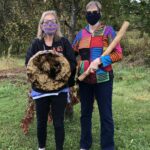
-
The guardian oak awaits the blessing of the labyirnth.
-
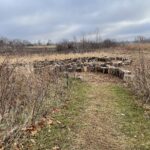
-
The stump labyirnth invites walkers.
-
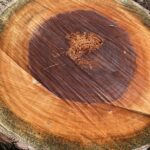
-
Each wood stump has a distinctive color and shape.
-
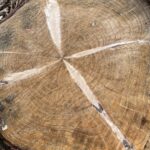
-
Various patterns on the rounds make an interesting walk.
-
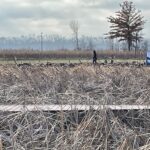
-
Creating beauty from destruction.
The Phoenix Harmony Labyrinth
We started the year with a mild winter’s day New Year’s Day Labyrinth Walk. Teri P. joined others walking for peace, tranquility, hope, and courage. Cold and snow hit later that week and the weather remained cold and snowy for several weeks. Each day, I strapped on snowshoes and crunched along the five-circuit dual entry labyrinth.
Practicing the Shamanic tradition, I often pause at each turn toward the Cardinal Points – East, South, West, North – Below to Mother Earth, Above to Father Sky, and Center – the emerging Bur Oak we planted a few years ago.
-

-
Some of us began the year with a New Years Walk.
-
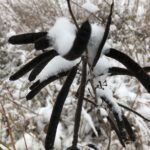
-
Snow captured on seedheads.
-

-
Any weather
Mostly I walk with Gratitude. For all – those I care about, those I don’t know, those I disagree with, and those I do not like. Asking for kindness in my heart and blessings to all. It’s hard sometimes. Insights are important, too. So, it’s OK to let my mind wander a bit and wonder. Nature. Seasons. Love. Hate. What drives people. Thankfulness for our families and this home and property.
-
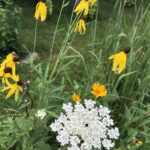
-
Summer denizens.
-
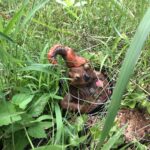
-
Each summer this gnome finds a new home.
-
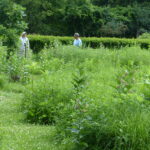
-
More species visit the labyrinth because of the diversity of plants.
-
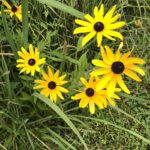
-
Summer riot of color attracts pollinators
-
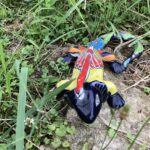
-
Up from Texas!
-
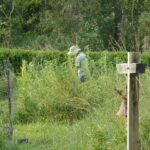
-
After the Derecho friends helped clean up the labyrinth.
Each day is different. The angle of the sun, sprinklings of rain, fog, presence of insects and birds. Tracks and poop in the snow are telltale signs of night visitors. Sometimes I walk before dawn even in winter, looking back at the house’s gentle glow from windows and smoke wafting from the chimney. Other times about 6:40 a.m. a neighbor’s truck lumbers up the road. We exchange a friendly wave. Occasionally, on early winter and summer nights I walk. The solar lights guide my way in winter. By summer the glow of twilight keeps me on the path. A bat swoops. A coyote yips. Crickets sing. Trees creak stiffly. Stars and planets glow.
-

-
One family regularly walks and runs the labyrinth on the astronomical and cross-quarter dates.
-
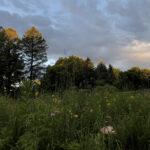
-
Summer delight was watching the sun kiss the sentinel fir trees.
-
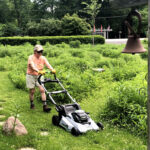
-
Maintaining the labyrinth is work. And a way to connect.
-
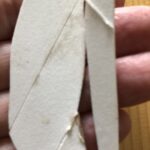
-
Remnants of the Derecho blown into the labyrinth.
-
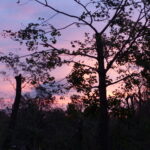
-
Sunrise after the derecho.
-
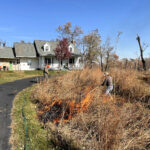
-
The most thrilling activity each fall is burning the Phoenix Harmony Labyrinth.
-

-
Evening walk by solar lights.
-
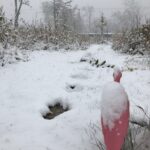
-
Surpise!
-
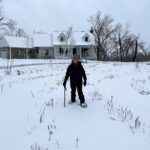
-
On our first lasting snow, I strapped on the snowshoes to walk the labyrinth.
It’s all good. A discipline and a joy.
by Winding Pathways | Jan 5, 2020 | Birds, Mammals, Nature, Uncategorized
When the next soft snow falls, go tracking outside! A mid-December 2019 skiff of snow delighted us. There was not enough of the white stuff to shovel but the thin white blanket that covered our yard revealed who visited the night before.
The dimples of deer tracks were clearly visible as we went out to get the newspaper, but one set of tracks was unusual and especially interesting. Four footprints, in a rough line, kept repeating with about three feet of untrod snow between them. Just what animal created them?
-
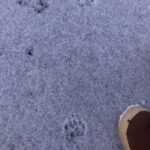
-
A skiff of snow is best for tracking.
-

-
A small bird left tracks in the snow.
-
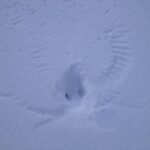
-
Gottcha!
After a bit of sleuthing, we decided it was a coyote out seeking a mouse or rabbit dinner. Coyotes aren’t rare around our home but they aren’t in the yard often. We wish we could have watched it lope across the yard.
A skiff of snow makes for a delightful walk in the woods, grasslands, or wetlands. Often animals are easy to spot as their dark coats contrast with the white snow and tracking is superb. It’s usually not hard to figure out what animal made the tracks, and following them gives some idea of what the animal was doing and where it was going.
Many Websites and books help with track identification but we like www.naturetracking.com because it shows tracks of animals most likely to be in a backyard.
Happy tracking.
-
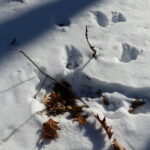
-
Squirrels at work.
-

-
Even humans leave tracks all over.
-
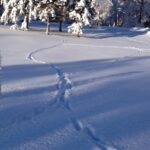
-
Deer paths are most obvious in deeper snow.
by Winding Pathways | Jan 2, 2020 | Birds, Nature, Travel/Columns
As dusk enveloped us, Sandhill Cranes winged over in groups of three or four, heading for their overnight roosting sites. We were at the Aldo Leopold Foundation near Baraboo, Wisconsin.
Conservation philosophers often cite three authors who framed the modern environmental movement. Perhaps Thoreau’s WALDEN is most famous. Somewhat later, John Muir penned the value of wilderness and national parks. More recently Aldo Leopold’s 1949 book, A SAND COUNTY ALMANAC, articulated society’s need to embrace a land ethic.
Extinction of Species
During Leopold’s life waterfowl, Passenger Pigeons, Sandhill Cranes, and many other birds declined in number under widespread habitat destruction and market hunting. The pigeon became extinct, and Leopold believed Sandhill Cranes would soon follow.
Happily, thanks to protection, education, and habitat improvement thousands of cranes now gather each fall near the Leopold Center on their way south. We had the good fortune to spot and hear many.
Foundation of Personal and Professional Life
In the winter of 1971 Rich worked as an elementary school custodian. “If I hustled and got the restrooms cleaned and the halls swept, I could take a short break in the janitor’s closet. There, surrounded by mops and brooms I read WALDEN and SAND COUNTY. They framed my personal and professional life,” he said.
Leopold was one of the first scientists to encourage making degraded land healthier through ecological restoration. His words inspired us to devote 40 years restoring prairies in Kansas and Iowa. Our Winding Pathways yard of waving wildflowers and tall grasses are a living tribute to Aldo and Estella Leopold.
A Walk into the Past Connects Us to the Present
Recently, Leopold Foundation Fellow Eudora Miao led us down a narrow path between tall pines to a former chicken house. In the 1930s the Leopold Family converted it to their weekend getaway cabin and called it simply, “The Shack.” Starting in 1935 they planted thousands of pines and acres of prairie on their eroded and barren land. It was here that Aldo penned words that have inspired people for the past 70 years.
The Foundation strives to inspire an ethical relationship between people and nature through Leopold’s legacy.
We were thrilled to visit the Foundation, tour their amazingly energy-efficient headquarters, visit The Shack, and interact with staff. Put SAND COUNTY ALMANAC on your reading list and visit the Foundation. It’s about ten miles from downtown Baraboo, Wisconsin, and about an hour’s drive north of Madison.
For information visit The Aldo Leopold Foundation
Photos (mn) by Mark Norlander.
-
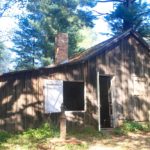
-
The converted chicken coop is on the Historic Register. mn
-

-
A skilled Fellow of the Leopold Center shares about The Shack. mn
-
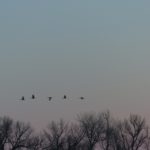
-
Sand hill Crane populations have increased.
-

-
The main building of the Leopold Center has Platinum LEED designation. mn
by Winding Pathways | Dec 26, 2019 | Birds, Mammals, Nature, Reflections/Profiles
We asked readers to send along some curious animal encounters.
Enjoy these guest blog entries as we wind down 2019.
From the East Coast to the Upper Midwest and ranging to Alaska and Hawaii people interact with or encounter wildlife in rural and urban areas.
Birds
SF: Lots to Raven About. “I saw my first ever raven yesterday — sitting and cawing on the roof of a car in a parking lot in Milford! JEESH! Do you think it was a portent of anything?
“Crows, of course, are extremely common; nevertheless, I love to see them in the huge groups they tend to gather in. I don’t know who assigned the collective nouns for species, but “Murder of Crows” is a favorite.
“Every time I hear that “caw” I look up hoping to see a raven, but I’ve never seen one until yesterday. I heard a ruckus as I got out of my car in a parking lot in Milford, NH, and saw one — sitting on top of a car and making his presence known. It was huge and oddly majestic, but sadly, it was a single bird, not an ‘unkindness of ravens’.”
AS: Birding Resort. Happenings were just ducky at a Hawaiian resort. And, this cock had something to crow about following a skeptical tourist. Who won? “The rooster lives near the food truck so it wins this match off.”
-
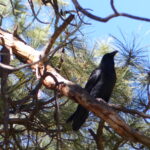
-
Ravens are huge and oddly majestic.
-

-
This rooster makes off great living near the food truck.
-

-
This duck wandered around the swimming pool at a Hawaiian resort.
JH: Eagle Encounter: Several years ago on my way to the Y swim class, I saw, to my total delight, a wondrous sight. As I approached my turn, I saw a huge bird just sitting on a fence post. I made the turn and slowly stopped my car, I recognized this critter as the American Bald Eagle. We each sat on our own perch eyeing one another. After carefully retrieving my camera, I snapped a couple of pictures.
The eagle kept an eye on me. Then, he spread his wings and laboriously lifted off, swinging to his left towards a telephone pole out in the pasture. As he landed, he tucked his wings into his sides and continued his watch. I suppose he was wondering what I was doing just as I was wondering what he had been doing as he sat on the fence post.
He had been just a couple of arm’s lengths from me. To be so close to him was awesome. I could only imagine what it would be like to stroke his beautiful feathers.
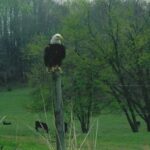
The eagle continued to eye me.
Mammals
JA: Albino deer. I caught some photos of albino deer in Wisconsin.
DP: Surprise Dolphins. “While reporting from Charleston, South Carolina, during the 2012 presidential campaign my colleagues and I stopped to look at the ocean. The city is surrounded on three sides by water and we expected to see lots of boats and people enjoying the water. We didn’t expect to encounter a school of dolphins! They swam around us for a few minutes and seemed to be having a lot more fun than we were.”
-
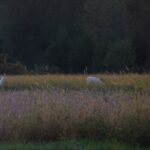
-
Two albino deer in a field.
-

-
Dolphin in a harbor.
NP&BO: Moose & Wolverines & Cats! Oh, my! Baby moose roaming an Anchorage neighborhood, munching on raspberry patches. Then, along comes mama and they stroll down the street. A lot of urban moose in Anchorage. Other parts of the city boast moose and black bears!
News from the North. Latest Anchorage crime as reported by the Anchorage Daily News: Yet Another Urban Wildlife encounter as cat survives wolverine attack near the Campbell Science Center.
-
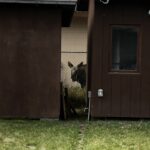
-
A curious calf moose looks across the lawn.
-
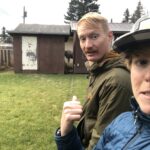
-
Munching raspberry bushes in the back yard.
-
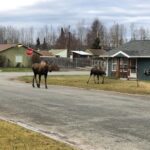
-
A curious calf moose looks across the lawn.
-

-
Strange things are seen in the land of the Midnight Sun.
North Woods Near Encounter
MN: Wolf Encounter. “My friend and I were camping in the BWCA in January, several years ago. At the end of a long day of cutting/splitting wood, fishing, snowshoeing and cutting more wood, we sat next to a blazing fire as the early sunset arrived and we were soon enveloped in darkness. The stillness of the forest in winter is amazing because there are no insects or other nocturnal creatures that make noise. On this windless night, there was no sound besides the crackling fire. Suddenly and without warning, we both had the feeling that someone or something was watching us from not far away. I slowly turned, and the fire was just bright enough to illuminate the face of a large wolf, 10 feet away. We froze, not knowing what to do. Had it been a black bear in summer, we would have started shouting and waving our arms to scare it away. But we weren’t prepared for this and had no idea what to do. So we just sat and watched. The wolf didn’t seem aggressive, and it slowly moved directly toward me. I remained motionless. It came right up next to me and sniffed my arm. I wondered, what I should do? I was a little too unnerved to do anything. The wolf seemed satisfied with my scent and moved on to my friend and smelled his boot. And then, just as quietly as he arrived, he slowly walked off into the woods. We sat there motionless, except for our eyes, all four of which were now the size of half dollars. We threw some more wood on the fire and waited, but the wolf did not return.
Mystery Solved
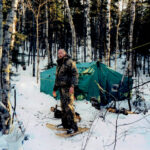
Comfortable digs on a winter campout.
“The next morning we got up and went out to fish. In the distance, on the other side of the lake, we saw someone doing the same. We decided to take a walk and share our wolf experience with this person. We greeted him and explained what happened and asked if perchance he had encountered the same wolf. He had indeed! And suddenly the wolf was bounding across the ice, coming straight for us. “Max, come on boy! Over here!” We were astounded that this guy was actually naming and calling wolves. “Do you know this wolf?”, we asked. He knew him all right. He owned this “wolf”, which was actually a mix – half-wolf, half-dog! We petted him and he licked our bare hands just as any dog would, especially since he was familiar with our scent after his visit to our campsite the previous night.”
Erma Herman Visits During a Cold Canadian Night
LF: Erma Herman. Though not snuggly, ermine are quite lovely little critters. Their Winter coat seems more purely white because of their black tails, bright black eyes and button nose. For several Winters I’ve enjoyed watching one that has visited our platform feeder to gnaw on the chunk of suet I put out for the birds. I marvel at the rapid movement, dashing back and forth, here one second, gone in a flash.
I’m guessing it’s one, as I’ve never seen two at the same time.
Last Winter, during a freeze/thaw period, after we had some plumbing issues that involved the plumber working in the crawl space under the house, we were visited by ‘Erma Herman’ in the middle of the night. I awoke to an alarmingly loud, squeaking/squealing sound coming from the kitchen and the cat “tharumping” across the floor, coming to a halt in front of the dryer, where I could see a tiny black nose poking out from underneath.
It had found its way in through the smallest of openings left by the plumber, making its way up the hoses for the washing machine and into the kitchen where the scent of cat food was calling. It took several nights, a mousetrap, which is still somewhere in the understructure of the house, several packages of steel wool and a roll of duct tape (Red Green would be proud) before it stopped coming in.
My neighbour, who no longer tries to keep chickens, is not a big fan of ermine, Winter or Summer.
-
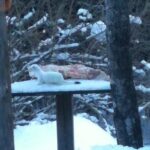
-
An Ermine climbed up and began gnawing on suet.
-
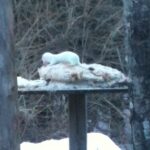
-
A white Ermine on the sudet feeder in Canada.
by Winding Pathways | Dec 12, 2019 | Birds, Chickens, Nature
As autumn progresses in the upper Midwest, birds appear and disappear, group and spread out. Pileated woodpeckers have returned to the suet feeders. Chickens help grind up the garden residue and eat the bugs. White-throated sparrows sing a different tune on their way south. Juncos suddenly appear. Bluebirds sit on branches surveying the yards. Hawks send everyone scurrying. Vultures wing one more time overhead before catching the north winds and head to warmer climes.
Watch these robins enjoying a sunny day bath.
-
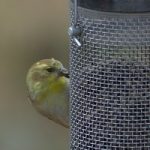
-
Songbirds appreciate high quality seed to sustain them in winter.
-
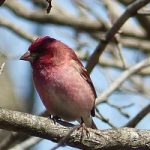
-
Some birds homestead at Winding Pathways.
-
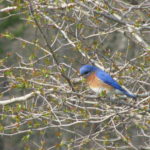
-
Bluebirds hang out on branches.
-
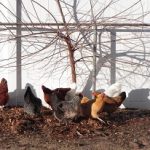
-
Chickens grind up garden residue.
-
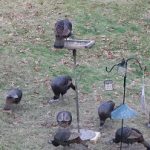
-
Turkeys and squirrels would make short work of seed, leaving none for the small birds.
-
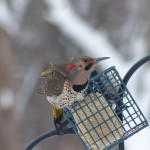
-
Winter is tough on birds so keep your feeders full.
-
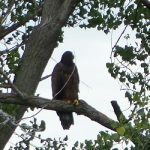
-
Fledgling eagle resting in the back yard.
-
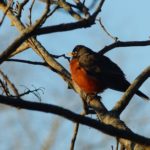
-
A robin surveys the area
























































